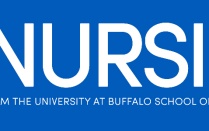It Takes A Community (Nurse)
Telehealth technology serves as a valuable teaching tool and expands access to care.
Published August 9, 2017 This content is archived.
HRSA Grant Extends SON's Reach for Underserved Populations
Clinical partnerships are vital to institutions of higher education. “Nurse practitioner education is dependent upon community partners to provide clinical practice sites for our students, offering valuable clinical experiences to students while helping to meet health care needs in our community,” according to Tammy Austin-Ketch, assistant dean for MS/DNP programs.
To help meet the growing need for advanced practice nurses in underserved communities, the University at Buffalo School of Nursing (SON) received two grants in 2016 for a total of nearly $2.2 million from the Health Resources and Services Administration (HRSA), an Advanced Nursing Education (ANE) Program grant and Advanced Education Nursing Traineeship (AENT) Program grant.
“With the combination of these two grants, we can potentially increase the number of health care providers in rural and underserved areas that are traditionally underrepresented by physicians,” says Austin-Ketch.
Partnerships for Service and Education
Rural, underserved communities, including Native American communities, are in dire need of health care and do not receive the requisite comprehensive care in a traditional health care setting. The HRSA ANE grant enables the SON to establish a new academic clinical partnership with the Niagara Falls Memorial Medical Center (NFMMC) and hire two primary care nurse practitioners (NP) to serve in rural and underserved areas while holding part-time positions as UB faculty. The NPs provide services at two Native American health care clinics – Tuscarora Health Center and Seneca Gaming Clinic – and Golisano Center for Community Health.
These on-site clinical faculty supervise students, allowing for an increased number of qualified students to be accepted into our FNP program and expanding community service opportunities.
The HRSA AENT program grant offers scholarship support to 12 full-time and 11 part-time students pursuing a doctor of nursing practice (DNP) degree. Family nurse practitioner (FNP) students with an interest in working in underserved communities can apply for specific health disparity clinical opportunities at the Native American clinics. Each semester, the grant provides students with 400 clinical practicum hours. Students not participating in the grant are able to rotate into the health disparity sites for observational experience.
Health Care from Anywhere
The ANE grant also provides for improvements to the telehealth capabilities of both UB and NFMMC by expanding infrastructure and technology services and offering students more experiential learning opportunities with the use of telehealth in a primary care practice.
Telehealth is a valuable teaching tool for sharpening students’ critical thinking skills. Unlike traditional clinical encounters where the faculty member is on-site, telehealth mimics “real life” practice, requiring the student to assess and examine patients and then evaluate and develop a treatment plan while remaining in the constant presence of the patient, with the faculty member observing via the technology. The process encourages patients to be engaged in their individual plan of care.
“The opportunity to utilize telehealth in the clinical setting has allowed me as a student nurse practitioner to practice my clinical skills in a more autonomous fashion compared to traditional clinical experiences, which has resulted in an improvement in my confidence level,” observes Quinn Maloney, DNP ’17. “Moreover, this opportunity has provided me the experiential learning necessary to competently use telehealth technology, an invaluable and marketable skill that I can take with me as I transition into my new career.“
Reciprocity in Serving the Underserved
For the past three years, all of our FNP students have chosen to work in underserved areas after graduation. Many received employment after their internship, while others returned to their home community to give back. This may be due in part to the attractive incentives for students to seek employment in underserved or underrepresented communities – there are a number of federal student loan repayment programs.
With changes in nurse practitioner collaborative practice agreements in New York State, practitioners are able to enter into autonomous practice in underserved or rural areas that historically do not attract physicians. “Students value telehealth experiences and view the method as a bridge from constant faculty supervision to independent practice,” says Austin-Ketch.
Clinical experiences in an underserved area, such as an inner city location or a rural community, attract students with a desire for work that allows them to utilize their full scope of practice within the confines of the practice agreement in their state of employment.
And, educating and placing more DNPs into the community allows schools of nursing to hire doctorally prepared nurse practitioners to teach current doctoral students, expanding (and improving) the pool of muchneeded DNP faculty candidates
Next Steps
In 2017 we received a $1.4 million Advanced Nursing Education Workforce Program Grant. The plan is to enhance our primary care academic-clinical partnership at NFMMC by integrating new behavioral health and primary care services, addressing a recognized gap in behavioral health care access to meet growing patient demand. Faculty plan to implement an augmented model of clinical and didactic education for our BS to DNP students in the FNP, AGNP and PMHNP programs – this will facilitate clinical experiences that deliver high-value integrated behavioral health primary care services.
By DONNA A. TYRPAK
Past Issues
We want to hear from our incredible alumni. Whether you live in Western New York or anywhere else in the world, stay in touch! Send us a class note.


